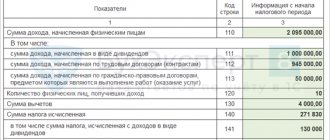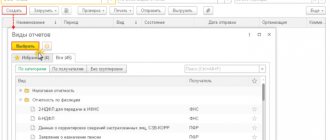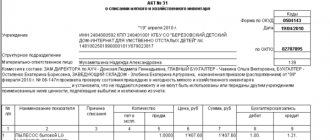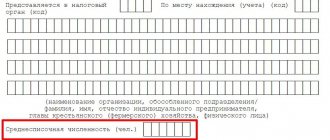Not all entrepreneurs are required to use cash register equipment in their business activities, but if such a device is properly registered with the INFS, then when using it, cash discipline must be strictly observed in order to avoid serious fines.
One of the mandatory elements of a cashier-operator’s job is the preparation of a Z-report. What kind of document is this, what is it for, what to do if it is lost, and what sanctions entrepreneurs may be subject to for incorrect Z-reporting - all in detail below.
What is a z-report
Z-report ( “Z-report” , also known as a cancellation report ) is the final cash receipt, which must be printed within 24 hours. It means completing the cash register shift, handing over the proceeds and resetting the cash register RAM. All data from the previous moment of cancellation remains in the fiscal memory of the cash register and on the EKLZ tape.
FOR YOUR INFORMATION! In the cash register there is a control tape (EKLZ - “electronic control tape protected”), on which all indicators from the meters are recorded. In cases where information on reports is lost for some reason, EKLZ is the only way to restore it.
From this document you can track:
- money counter data at the beginning and end of the shift;
- the total amount of proceeds until cancellation;
- the amount of refunds, if any;
- the amount of discounts provided;
- amount for canceled checks.
The essence of the process of implementing online cash registers
From July 1, 2017, cash registers of a new type - online cash registers, characterized by:
- a higher degree of security for sales data generated on them;
- the ability to transmit this data in real time to the Federal Tax Service.
At the same time, a number of changes were introduced:
- to the list of persons obliged to use CCP;
- procedure for registering and using cash registers;
- register of mandatory details of documents generated by the cash desk.
However, despite a fairly wide range of changes in working with cash register systems, the essence of these changes boils down to the fact that cash registers of a technically higher level began to be used for cash payments. And it was precisely this circumstance that caused most of the changes in the procedure for working with them. These changes did not affect the rules for accounting for revenue received through cash register systems, despite a number of innovations in the documentation of some cash transactions. Therefore, the question of how to keep records at online cash registers has only one answer: in the same order as before. There are no innovations in it.
Some businesses, usually online stores, prefer to use cloud services instead of cash registers. A cloud online cash register is a service through which an online store connects to a remote online machine located in the service’s data center. All information about calculations is carried out through this device, which is transmitted through the fiscal data operator to the tax office. And the cloud service ensures the connection of cash registers to the online store website, setting up online cash registers and uninterrupted access to them.
The cloud service allows you to rent several cash registers without a cash register and register them with the tax office.
We've taken the Z-report, what's next?
The printed check with the final report must be pinned or glued to the “Cashier-operator’s certificate-report”. The following information is entered into the cash register as a separate line:
- date of each document;
- his number;
- gross total (sum at the beginning and at the end of the shift);
- amounts of sales, returns, discounts, etc.
Together with the recorded revenue, the cash register at the end of the shift (working day) is handed over to the senior cashier, to the accounting department or personally to the manager (depending on how this is established by the internal procedure of the organization).
The collected Z-reports, as well as used EKLZ, must be stored for at least 5 years; the manager is responsible for the timing and safety.
IMPORTANT! Take care of these documents, do not lose or throw away the taken Z-reports, even if they were carried out by a foreman when setting up the cash register, contain zero indicators, or were taken as a test. Absolutely all canceled reports must be recorded in a journal.
How to run a z-report on the terminal?
The generation of such reporting does not require additional financial and physical costs. A modern cash register is already programmed for this function and independently creates a z-report. For this purpose, information obtained during the shift is sufficient. The cashier must press buttons in a certain sequence
and the final document will print.
The cashier's actions will differ slightly depending on the terminal model, but the principle of generating the report is unchanged. Based on the standard sample, the operator selects the required items in the menu on the touch screen or presses the required buttons.
Sequence of steps:
- Find the “Closing cash register” position and enter it.
- In the menu that appears, activate the “Close shift” link.
- As a result of the manipulations performed, a check is printed and filed in a special folder.
If you cannot remove the cash register automatically, you should resort to manual printing. In the initial list of transactions, select “Cash reports”. Then the appropriate command is entered and the document is printed.
Daily control
“Zetka” is a document of strict financial reporting.
It must be removed after a shift or working day, but at least once every 24 hours. If this is not done, the cash register will be blocked. All cash registers, as required by law, are equipped with an automatic locking system when a 24-hour shift is exceeded. Until the Z-report is removed, the cash desk will not be able to perform any operations.
What if there were no operations?
The SFSU letter dated February 10, 2015 clarified that zero reports do not need to be printed if not a single cash transaction has been completed within 24 hours. However, often internal documents of an enterprise require opening and closing a shift, regardless of the passage through the cash register. In addition, in practice, small money is most often stored in the machine, and this is also finance that must be carried out daily through the cash register (“service deposit”), and this is an operation that will be reflected in the Z-report.
Until legislators have clarified this issue completely, it is better to print the Z-report daily and register it in the cash book, even if it is zero, to avoid troubles.
Taking out a Z-report the next day
The nuances of working with z-reports, and how not to violate reporting rules if a shift is closed at the wrong time
Often in practice a situation arises when a z-report is removed the next day, for example, for technical reasons or due to a seller’s error.
In this case it is necessary:
- Before opening a new cash register shift, generate a z-report for the previous day;
- make two entries in the cashier-operator’s journal, dated on the same date;
- reflect two separate receipt orders in the cash book.
In addition, you should take written explanations from the cashier regarding the reasons for this situation.
Removal of the report the next day may be regarded by the inspection authorities as a violation of the rules for working with cash register equipment. Despite the fact that there is no direct penalty for this, this fact can be qualified as untimely receipt of funds, which, in turn, carries serious tax risks. According to clause 6.1. Standard rules for the operation of cash registers, approved by the Ministry of Finance dated August 30, 1993 No. 104 and clause 5.2 of the Procedure for conducting cash transactions, approved by the Central Bank dated October 12, 2011 N 373-P, based on the z-report taken, a certificate-report KM-6 is drawn up and submitted along with revenue from a cash receipt order to the cash desk. In the case under consideration, the determination of revenue does not occur on the day of its actual receipt, and administrative liability is already provided for this in accordance with clause 1 of Art. 15.1 Code of Administrative Offences.
However, it should be taken into account that the organization’s operating mode may provide for the end of the shift after 23:59:59, that is, on the next calendar day . This point is regulated by law: clause 3.8 of the Technical requirements for the fiscal memory of electronic cash registers (Decision of the GMEC dated 06/23/1995, protocol N 5/21-95) stipulates that a cash register shift should be limited to calendar days or should not exceed 24 hours . In this case, income must be determined and reflected in the cash book based on the results of closing the cash register shift. That is, the reflection of revenue in accounting the next day will not be considered a violation of cash discipline.
In the Resolution of the FAS UO dated December 22, 2009 N F09-10179/09-S3, the judges came to a similar conclusion: if the journal, z-report and receipt order are drawn up at the end of the work shift, which does not coincide with the beginning of the calendar day, the revenue was legally generated at end day of the shift. If plastic cards are used in calculations, income is reflected on the basis of clause 1 of Art. 346.17 of the Tax Code, namely at the time of receipt of money to the current account (Letter of the Ministry of Finance dated 04/03/2009 N 03-11-06/2/58).
Despite the fact that with the start of using the new type of cash registers, there will be no need to maintain a journal for the cashier-operator and take out z-reports, nevertheless, the obligation to timely capitalize cash proceeds will remain. Also, the issue will remain relevant for those taxpayers who have several cashiers working alternately on one cash register.
Features of the Z-report
- Each cancellation report has its own serial number, so there should be no gaps in the cashier’s journal.
- It cannot be removed or canceled again, since it is recorded in the fiscal memory of the device and on the control tape.
- If no cash transactions were made within 24 hours, you can issue a zero Z-report.
- During a shift or working day, you can take any number of Z-reports; each must be issued separately and filed with the operator’s certificate.
- After printing the Z-report a second time, it cannot be withdrawn until any cash transaction is carried out.
NOTE! The very first report with cancellation, taken to the INFS when registering the cash register, will remain there: its absence will not in any way affect the correctness of the cash register. But with all the subsequent ones you should be especially careful.
Do I need a Z-report for online checkout?
The report, which is an analogue of the Z-report, is also available in online cash registers. It is called a shift closure report and, essentially, just like the Z-report, it is tied to a time period of 24 hours. The presence of such a restriction follows from the prohibition on the possibility of generating cash register receipts (or BSO) after this number of hours has elapsed from the moment of generating another report - on the opening of a shift (clause 2, article 4.2 of the law “On the use of cash registers ...” dated May 22, 2003 No. 54- Federal Law).
What happens if you generate a report on the closure of a shift using online cash register the next day after the end of the shift? You will find the answer to this question in ConsultantPlus. Trial access to the system can be obtained for free.
When generating a shift closure report in the online cash register, the following does not occur:
- data reset;
- fixing the final result in fiscal memory.
However, this report still solves all other tasks (summarizing results and generating documents necessary for drawing up reports necessary for posting revenue to the operating cash desk).
Its additional function is the immediate automatic transfer of data to the controlling Federal Tax Service. Moreover, if there is no confirmation that the tax authority has received this report, the online cash desk will send it again.
Just like other reports generated by the online cash register, the shift closing report is stored in the fiscal drive in electronic form in a form protected from corrections for at least 30 calendar days (Clause 4, Article 4.1 of Law No. 54-FZ dated 22.05.2003 ). For the purpose of entering data into documents intended for the operating cash desk, it can be printed on paper.
The Law of May 22, 2003 No. 54-FZ (clause 5 of Article 4.1) for the report on the closure of a shift provides a set of mandatory details, and the order of the Federal Tax Service of Russia dated September 14, 2020 No. ED-7-20 / [email protected] - a list of mandatory additional data that depends on the format of the fiscal documents used.
The Z-report is lost, what should I do?
In life, anything can happen, and even an irreplaceable report with cancellation may, for some reason, not be documented in the journal as it should be. This most often happens:
- with inexperienced employees who unknowingly throw away such an important check;
- due to the repair of the device, when the report is punched out by the master for verification, they do not always think to save it;
- if the receipt was not printed due to a breakdown of the cash register, problems with the ribbon or paper, or a power outage;
- if the check is lost;
- when the document is torn, worn out, flooded, or damaged in some other way.
The absence of a Z-report threatens the company with large fines. To avoid them, you need to immediately follow the procedures prescribed by law when you discover the loss of the socket.
Sequence of actions when detecting the loss of a report with cancellation
- Draw up an act of loss of the Z-report (it must be signed by the shift cashier, the senior cashier, if there is one, the company’s accountant and a representative of the administration).
- Oblige the cashier to provide an explanatory note, which will highlight the time and circumstances of the loss of the report, as well as the reasons why the required information was not entered in the cash register.
- Achieve receipt of a fiscal receipt according to EKLZ data, confirming revenue for a shift with a lost Z-report. To do this, you will have to call a technician from the KKM service center.
- The fiscal report taken for the required period should be drawn up in the cashier's journal instead of the lost Z-report.
IMPORTANT! The manager has the right to impose punishment on the cashier guilty of losing a strict reporting document, if he deems it necessary based on the results of his explanatory note. There is no dismissal for such an offense, but a reprimand or verbal warning is quite likely.
Partial payments
The vast majority of retailers use FFD 1.0 and do not experience any problems. Indeed, typical retail sales in stores, to which we are all accustomed, imply that the amount of payment is equal to the cost of goods, and shipment occurs at the time of payment.
Problems begin when you need to issue a check for partial payment for goods. And this is a fairly broad list of cases:
- Payment with a gift certificate or bonuses.
- Sale of goods to order (for example, furniture).
- Public transport, passenger, rail and air transportation.
- Sports and other entertainment events.
- Parking with account replenishment via a mobile application.
- Selling subscriptions to electronic magazines.
Wholesale trade is also required to use cash register systems if payments are made in cash or electronic means of payment. And it becomes problematic to process partial payments in cash. After all, in case of partial payment, the amount of the goods part does not coincide with the payment amount. Each transaction is issued with at least two checks - for receipt of funds and for shipment. In the footer of the check the settlement amount is indicated: the amount of accepted payment in cash or electronic means and the settlement amount for goods. Therefore, using the usual “retail” approach, we get an overall overstatement of turnover for the transaction.
Examples
Let's take as an example the sale of one adult and two children's cribs - in the amount of 14,000 rubles. two checks for cash. For clarity, during one shift. 30% is paid at the time of shipment (RUB 4,200). 70% - by the second check (9800 rubles).
How the sale is reflected in the receipt with FFD 1.0
The fact that this is a partial payment is indicated directly in the name of the product. The check amount is equal to the transaction amount, VAT is calculated correctly. The payment amount was paid in cash (RUB 4,200). But the amount of future payment on credit is classified as an electronic means of payment, since this format does not know other forms of payment.
With the second check everything happens symmetrically. Payment of the loan, accepted in cash, is also reflected correctly, the offset of the advance is also attributed to electronic means of payment.
More than 80% of cash register users today use FFD 1.0. What to do if you are not satisfied with the described absurdities? Yes, actually, nothing. Tax officials characterize it simply - “everything is piled up.” To deal with the “heap”, they came up with a format extension.
FFD 1.05
In addition to many other details, format 1.05 introduced the attribute “sign of calculation method”. Seven characteristics of the payment method are established, with the help of which the most popular partial payment schemes are described: 100% prepayment, prepayment, advance payment, full payment, partial payment and credit, transfer on credit, loan payment.
In the footer of the check in format 1.05, compared to FFD 1.0, new details have appeared that clearly indicate accounting for the turnover of partial payments:
- settlement amount indicated in the check (BSO),
- check amount (BSO) in cash,
- check amount (BSO) electronic,
- check amount (BSO) in advance (advance offset),
- check amount (BSO) postpaid (on credit),
- check amount (BSO) by counter provision.
And at the end of the shift, more counters for the shift are added in the corresponding sections.
Check with FFD 1.05
As you can see, it is very beautifully highlighted in each line what it is. Partial payment and credit. The amount of the check is determined by the amount of product lines, equal to the transaction amount. The payment amount was paid in CASH, but with regard to payment on credit, it is already written in a completely human way that this is a SUBSEQUENT PAYMENT (CREDIT).
Second check. We accept subsequent payments in CASH, and the offset advance payment is also quite honestly indicated as ADVANCE PAYMENT (ADVANCE).
What you need to pay attention to here is the amount RECEIVED in the first check. The full amount is indicated here, although we received only part of it. (Revenue “received” sums cash flow and liabilities). We are working with the CCP manufacturer on this topic, the situation will change in the near future.
But, despite the shortcomings, we understand that when using version 1.05, more detailed information is sent to the Federal Tax Service, which allows you to correctly evaluate business transactions. Therefore, for enterprises that use partial payment schemes, it is necessary to switch to format 1.05.
How to go from 1.0 to 1.05?
The current order of the Federal Tax Service establishes the rules for the transition from version to version. You can switch only at the time of replacing the fiscal drive.
“The value of the attribute “FDF version number” (tag 1209) is determined at the time of generation of the registration report or re-registration report in connection with the replacement of the FN and cannot be redefined until the generation of a new re-registration report in connection with the replacement of the FN,” says the Order.
However, the FFD 1.0 format is so inconvenient and insufficient that an amendment is being prepared that will cancel this requirement. In the meantime, some manufacturers are offering on the market a transitional version of FFD 1.0+ drivers, which supports some tags that are optional for 1.0. In particular, a sign of the calculation method that we are talking about today. As well as Total Receipt Indicators and Shift Turnover Indicators.
Check with FFD 1.0+
All partial payment calculations are displayed absolutely clearly, postpayment on credit is reflected.
The second check - the advance offset is highlighted, the payment of the loan in cash is indicated, and even the amount of funds received is correctly determined. And to switch to 1.0+ you only need to update the software at the checkout.
How to close a shift?
As you know, the forms of primary accounting documents for recording cash settlements with the population when carrying out trade operations using cash register equipment (from KM-1 to KM-9) have now been cancelled. These include a book and certificate from the cashier-operator, as well as a log of cash register indicators. They can be kept for your own needs (to determine financial liability), but they are not needed for inspections.
Since the Federal Tax Service, when analyzing, mainly focuses on the checks themselves, the value of the Z-report has noticeably decreased. However, it was replaced by another document - the Report on the status of the meters. You just need to learn to read it.
Forgot to take a Z-report on time?
At the end of the shift, they didn’t remove the cap, but performed this action at the beginning of the next day? This often happens, however, this is a violation that, once caught, the tax authorities will not skimp on fines. The reason will be that, according to the documents, the proceeds will be untimely capitalized.
You should not rely on the fact that the tax office will not compare the dates of reports and the posting of money to the cash desk. It may well happen that a violation “comes to light” as a result of servicing representatives of a legal entity. Having received a check for a product or service stamped on a certain date, he can submit it to the accounting department of his organization for a report on the finances spent. A counter-check is quite possible, as a result of which it will become clear that the money received according to the presented check was capitalized not on the day of receipt, but later.
There is a special situation with entrepreneurs using the simplified tax system, who are required to show revenue in KUDIR on the exact date when it ended up in the cash register. If a check for a purchase or service is issued today, and the Z-report on it is going to be taken out only tomorrow, then in KUDIR there will be a discrepancy: you will have to indicate today’s check against a “z” that has not yet been taken out, according to which the checks will already be from yesterday.
NOTE! Isolated cases of untimely withdrawal of a canceled report can go unpunished: after all, they can also be caused by technical problems, this can be reflected in the explanatory note. It is important not to allow such cases to become a regular practice.
Z-report on cash register: sample
In appearance, shift closure reports generated on different cash registers are not much different - they contain mandatory details. But small differences still exist. Samples of Z-reports for the cash register with FFD 1.05 and FFD 1.1 are presented below.
And this is a sample report on shift total counters (implemented in FFD 1.1). It prints non-zero counters for the shift: the current one (if it is open) or the last closed one (if it is closed).
Next is a sample report on shift total counters (only for FFD 1.1), information about which is stored in the FN, for the entire period after registering the cash register with the Federal Tax Service:
Let's summarize: what is a cash register Z-report? This is a document generated daily at the end of the work shift. It contains data on transactions performed for the day. After printing the report, the cashier closes the shift and clears the cash registers.
Technical support of equipment. We will solve any problems!
Leave a request and receive a consultation within 5 minutes.
Sanctions and fines for violations of the Z-report
Violations of Z-reporting identified by a tax audit are fraught with serious fines for the organization’s management.
The absence of one or more “points” is a violation of Article 19.7 of the Code of Administrative Offenses of the Russian Federation, since in fact this is a failure to provide representatives of government bodies with the information they require.
For this, officials can be fined in the amount of 300 to 500 rubles, and legal entities - tenfold.
If tax authorities consider that unfiled Z-reports constitute disobedience to the requirements of the supervisory authority (Article 19.4 of the Code of Administrative Offenses of the Russian Federation), then a fine can be issued in the amount of 1,000 to 2,000 rubles.




